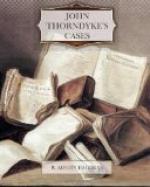“I have been telling Dr. Thorndyke about these nervous troubles of yours,” said Mr. Brodribb presently. “I hope you don’t mind. He is an old friend, you know, and he is very much interested.”
“It is very good of him,” said Calverley. Then he flushed deeply, and added: “But they are not really nervous, you know. They can’t be merely subjective.”
“You think they can’t be?” said Thorndyke.
“No, I am sure they are not.” He flushed again like a girl, and looked earnestly at Thorndyke with his big, dreamy eyes. “But you doctors,” he said, “are so dreadfully sceptical of all spiritual phenomena. You are such materialists.”
“Yes,” said Mr. Brodribb; “the doctors are not hot on the supernatural, and that’s the fact.”
“Supposing you tell us about your experiences,” said Thorndyke persuasively. “Give us a chance to believe, if we can’t explain away.”
Calverley reflected for a few moments; then, looking earnestly at Thorndyke, he said:
“Very well; if it won’t bore you, I will. It is a curious story.”
“I have told Dr. Thorndyke about your voyage and your trip down the Mediterranean,” said Mr. Brodribb.
“Then,” said Calverley, “I will begin with the events that are actually connected with these strange visitations. The first of these occurred in Marseilles. I was in a curio-shop there, looking over some Algerian and Moorish tilings, when my attention was attracted by a sort of charm or pendant that hung in a glass case. It was not particularly beautiful, but its appearance was quaint and curious, and took my fancy. It consisted of an oblong block of ebony in which was set a single pear-shaped pearl more than three-quarters of an inch long. The sides of the ebony block were lacquered—probably to conceal a joint—and bore a number of Chinese characters, and at the top was a little gold image with a hole through it, presumably for a string to suspend it by. Excepting for the pearl, the whole thing was uncommonly like one of those ornamental tablets of Chinese ink.
“Now, I had taken a fancy to the thing, and I can afford to indulge my fancies in moderation. The man wanted five pounds for it; he assured me that the pearl was a genuine one of fine quality, and obviously did not believe it himself. To me, however, it looked like a real pearl, and I determined to take the risk; so I paid the money, and he bowed me out with a smile—I may almost say a grin—of satisfaction. He would not have been so well pleased if he had followed me to a jeweller’s to whom I took it for an expert opinion; for the jeweller pronounced the pearl to be undoubtedly genuine, and worth anything up to a thousand pounds.
“A day or two later, I happened to show my new purchase to some men whom I knew, who had dropped in at Marseilles in their yacht. They were highly amused at my having bought the thing, and when I told them what I had paid for it, they positively howled with derision.




